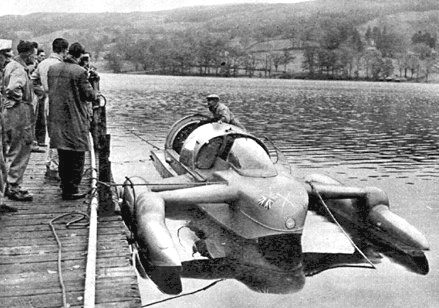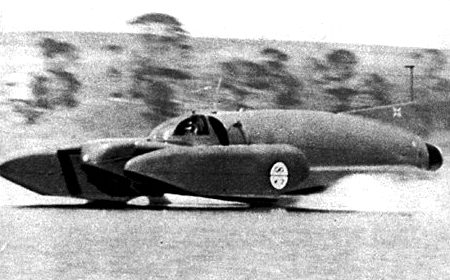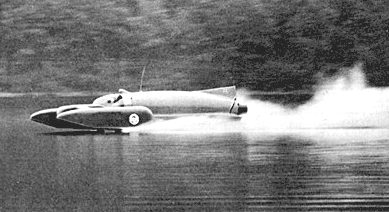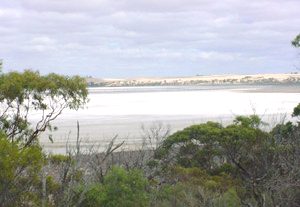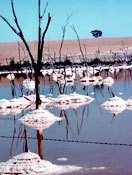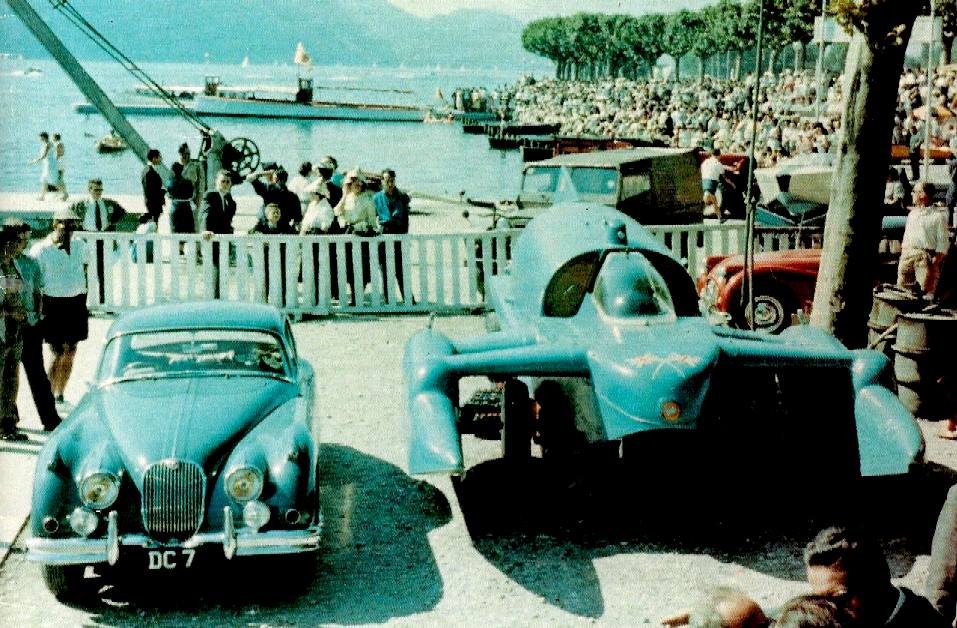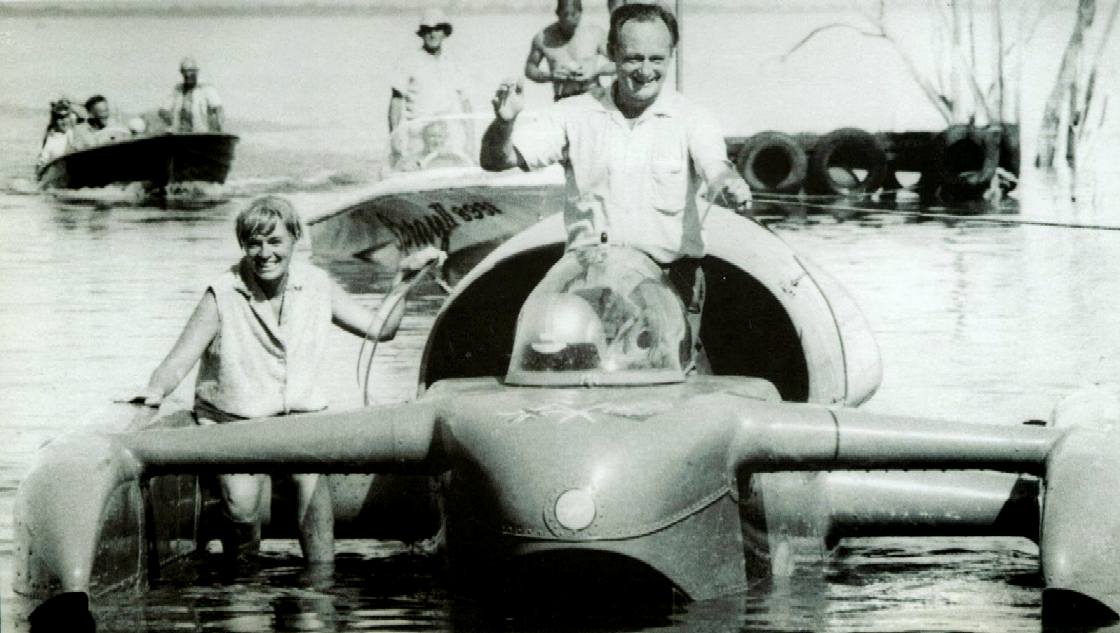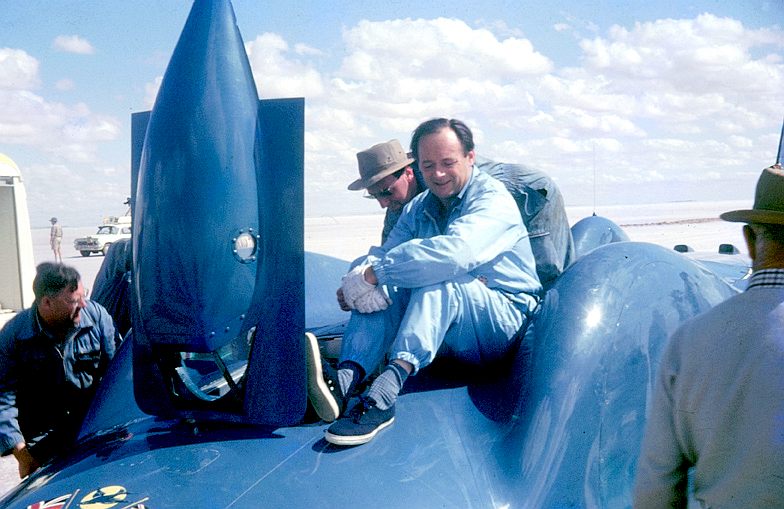|
DONALD CAMPBELL CBE - LAKE DUMBLEYUNG
|
|
|
31 DECEMBER 1964 - Campbell speeds to double record
Donald Campbell broke the world water speed record, becoming the first man to break the world land and water speed records in the same year.
He reached an average speed of 276.33mph (444.71km/h) in his speedboat, Bluebird, on this afternoon on Lake Dumbleyung in Perth, Western Australia.
The feat shattered his previous world record of 260.35mph (418.99km/h) at Lake Coniston, Cumbria, in 1959.
Bluebird K7 Coniston 1957
Campbell has been trying to realise his record-breaking attempt for months at various locations in Australia. Each time he has been frustrated. The weather at his first choice of location, Lake Bonney in South Australia, proved too unpredictable. Then, he moved to Lake Dumbleyung, near Perth, on 16 December, only to be delayed by wild ducks which could not fly away because they were moulting.
The weather was the next setback, as persistent easterly winds raised waves up to 2ft (61cm) high, making any attempt impossible. With time running out for him to achieve his goal of breaking both speed records in the same year, he began considering a move to a third lake just south of Perth.
The four timekeepers at Bluebird's (K7) record breaking run
at Lake Dumbleyung were: Warren Mathews, Don
Reimann -deceased, Don Noack, and Rod Style Sr.
'LET'S
GO SKIPPER'
Then
suddenly, on the last possible day, the winds eased and the lake became
flat calm. Conditions were rated 95% suitable, and the chief
mechanic, Leo Villa, radioed to Mr Campbell, "I think it's worth a
try - let's go, skipper!" Several hundred people gathered on the
shores of the lake to watch, among them Mr Campbell's wife, Tonia Bern. When
she heard that he had done it, she dived into the lake and swam out to
embrace him as he brought Bluebird in. As he stepped ashore, Mr
Campbell told his supporters, "It's amazing that we clinched it. I
never thought we had the chance of a snowball on the desert of cracking it
today." Mr Campbell broke the land speed record in July on Lake Eyre
salt flat in central Australia, with a speed of 403.1mph (648.72km/h).
Bluebird
K7 Lake Dumbleyung 1964 However,
the record was short-lived: on 27 October an American, Art Arfon, drove
his jet car across Bonneville Salt Flats in Utah at an average speed of
536.71mph (863.75km/h). Donald
Campbell attempted to break his own speed record a little over two years
later, on 4 January 1967. A
split second before his jet-powered boat, the Bluebird K7, broke the
record, travelling at more than 300mph (483km/h) on Coniston
Water, the boat's nose lifted and it was catapulted 50ft (15m) into
the air. Mr
Campbell was killed instantly as the boat hit the water and disintegrated.
He was 46 years old. His body was not recovered for another 34 years,
until 2001. His remains were buried near Coniston Water. Donald Campbell
is still the only person to break both land and water speed records in the
same year. He
remains the last British man to break the world water speed record. In
1978, it passed to Australia, when Ken Warby
reached a speed of 317.6mph (511.1km/h). BLUEBIRD
K7 The
K7 was a very successful boat that set 7 World
Water-Speed records between 1955 and 1964. The first record run was at
Ullswater where Donald set a record of 202Mph. In the same year this was
raised to 216mph at Lake Mead. There followed a sequence of record raising
runs at Lake Coniston where he attained 248mph in 1958 and on each
successful attempt Donald collected the £5,000 prize money offered to
anyone who broke the record by Billy Butlin, of holiday camp fame.
The prize money was a good way to finance the project and may explain so
many incremental records. Donald finally raised the water speed
record to 276mph at Lake Dumbleyung, Australia in 1964, having earned a
theoretical £35,000 prize money. Bluebird
K7 Coniston 1958
DUMBLEYUNG
Dumbleyung is a small wheatbelt town located 275 km south east of Perth. No one knows exactly how the town got its name but it is likely that it is a corruption of the local Aboriginal word 'dambeling' which probably meant 'large stretch of water'. An alternative theory argues that it may well be derived from 'dumbung' which either meant a native pear tree or an Aboriginal game played with bent sticks and a hard piece of fruit.
The explorers Henry Landor and Henry Maxwell Lefroy are usually credited with the discovery of Dumbleyung Lake, although it appears to have been shown on a map in 1839 with the name Kondening Lake. Grazing leases around the lake were first granted to George Kersley in 1875.
In recent times, the increased soil salination has made the area unsuitable for grazing. Today the lake is mainly used for aquatic recreation. Despite the extreme salinity of the lake, it provides a habitat for many varieties of water birds, and since 1963 has been protected by the Dumbleyung Lake Nature Reserve.
Although in many ways Dumbleyung is a typical wheatbelt town there is one event in its history which makes it uniquely important and separates it from the dozens of other towns in the area.
Lake Dumbleyung full of water
Dumbleyung Lake, also widely known as Lake Dumbleyung, is a salt lake in Western Australia. It is located at 33° 20' S, 117° 39' E, in the Great Southern region of Western Australia. At 13 kilometres long and 6.5 kilometres wide, it covers an area of 52 km².
On New Years Eve 1964, after a particularly wet winter had seen the lake fill to overflowing, Donald Campbell set the world water speed record when he raced his boat Bluebird across the lake at the remarkable speed of 444.66 km/h (276.3 mph). This made him the fastest man both on land and on water. A unique double.
A memorial to Donald Campbell's achievements is located on Pussy Cat Hill on the lake shoreline. Offering excellent views over the lake, it is clearly signposted 'Scenic Drive - Lake Dumbleyung' on the road from Wagin to Dumbleyung.
Lake Dumbleyung, undoubtedly the area's great attraction, is the largest natural body of inland water in West Australia. It is approximately 13 km long by 6.5 km wide with a catchment area which extends approximately 64 km north towards Kulin, 64 km south towards Narrangerup and 55 km east to Tarin Rock.
In the years when it overflows the water takes a course through the Wagin Lakes into the Beaufort River, thence the Blackwood and into the sea at Augusta.
The first recorded sighting of the lake was in 1843 when two explorers Henry Landor and Henry Maxwell Lefroy travelled through the area looking for pastoral lands and a large body of water which had been mentioned by the local Aborigines.
Landor and Lefroy described Lake Dumbleyung in their journal entry for 17 January 1843. 'After riding 10 miles, we came in sight of Dambeling, the largest of the lakes - 13 miles by 7 or 8. It is like the others, shallow with many low islands in varied and beautiful form. On the northern and eastern shores, there is a good grazing country down to the lake, ending in precipitous banks and extending over the hills 2 or 3 miles distant from the lake. The water is salt and the shore long, flat and muddy, on which we saw the impressions of two stray horses and a foal...'
Lake Dumbleyung drying out
The first grazing leases around Lake Dumbleyung were granted in 1875 to George Kersley who overlanded sheep from Beverley and took up a lease of 20 000 acres which included half of the lake. Early accounts describe the lake as having grass covered banks and the saltbush provided valuable grazing for Kerseley's stock.
The pastoralists were followed by the sandalwood cutters who came through the area searching for the aromatic timber. It was also common for farmers to cut the timber as it was a ready source of income during hard times or periods of inactivity.
Other early accounts describe a road across the lake used by Katanning settlers to cart produce to the goldfields in the 1890s. This was the opportunity for local farmers to make a fortune as quickly as the miners. They would load their wagons with flour, sugar, oatmeal, jam and baking flour and when they got to the goldfields actually auction their produce.
While the lake is used for aquatic recreation today, in the early 1900s there were race tracks on it and it was used for picnics. During the 1920s and 1930s, although the lake did not fill to overflowing, there were years when it had enough water for swimming and boating. A record wet year in 1946 saw the lake fill completely.
In recent times the lake has suffered greatly from the salination which has affected the whole of the wheatbelt. It now has a very distinctive saline smell. The shorelines, which the early settlers described as being so rich and fertile, are now characterised by forests of dead trees standing like forlorn skeletons. Most of the lake is part of a water bird conservation area. In March 1985 a total of 24 839 birds were counted on the lake.
The town of Dumbleyung seems to run a rather poor second to the lake but it is not without its charm. It came into existence just prior to World War I. The township was proclaimed in 1906 and the railway arrived a year later. From 1907-1912 Dumbleyung was the railway terminus which meant that it became an important meeting place. The Dumbleyung Hotel was built in 1913 and by 1915 Dumbleyung was the major rural service town in the region.
Things to see - Lake Dumbleyung and Donald Campbell memorial
A memorial to Donald Campbell's achievements is located on Pussy Cat Hill on the lake shoreline. Offering excellent views over the lake, it is clearly signposted 'Scenic Drive - Lake Dumbleyung' on the road from Wagin to Dumbleyung.
Lake Dumbleyung, undoubtedly the area's great attraction, is the largest natural body of inland water in West Australia. It is approximately 13 km long by 6.5 km wide with a catchment area which extends approximately 64 km north towards Kulin, 64 km south towards Narrangerup and 55 km east to Tarin Rock.
Heritage Trail and History
There is an excellent book on the area titled A History of Dumbleyung written by Terry Klemm. It is available from the Shire of Dumbleyung office on the corner of Harvey and Dawson Streets.
NATIONAL MOTOR MUSEUM, BEAULIEU - 50th ANNIVERSARY BLUEBIRD CN7
A celebration Evening is to be held on Saturday 19th July 2014 at the National Motor Museum, Beaulieu.
On 17 July 1964, despite mechanical problems and unpredictable weather, Donald Campbell and his team persevered to set a new British Land Speed Record of 403.10mph in Bluebird CN7, at
Lake Eyre in Southern Australia.
For more information & ticket prices visit http://www.beaulieu.co.uk/cn7
DONALD CAMPBELL'S BLUEBIRDS
The blue bird legend continues. The classic lines of this electric racing car were inspired by Reid Railton and his designs for the Napier Lion and Rolls Royce engined Blue Bird LSR cars in the 1930s, the Blueplanet BE3 features instant battery recharging using the patent Bluebird™ cartridge exchange system under license from BMS. This LSR is also solar assisted. She is designed for speeds in excess of 350mph using clean electricity. Imagine the spectacle of this beautiful vehicle speeding across the salt at Bonneville, or flying past on the sand at the Daytona or Pendine beaches. To hire this vehicle for your venue please contact BMS and ask for Leslie or Terry. The BE3 team need at least 3 months advance notice of events.
SIR MALCOLM CAMPBELL'S BLUE BIRDS
LINKS & REFERENCE
Warren Matthews is member of Kombi Club Australia http://forums.kombiclub.com/index.php Treasure houses CN7 50th anniversary celebration evening with Tonia Bern-Campbell http://treasurehouses.blogspot.co.uk/
|
|
|
This
website is Copyright © 2015 Bluebird Marine Systems Limited.
The names Bluebird™, Bluefish™,
Ecostar
DC50™, and the blue bird in flight
|
